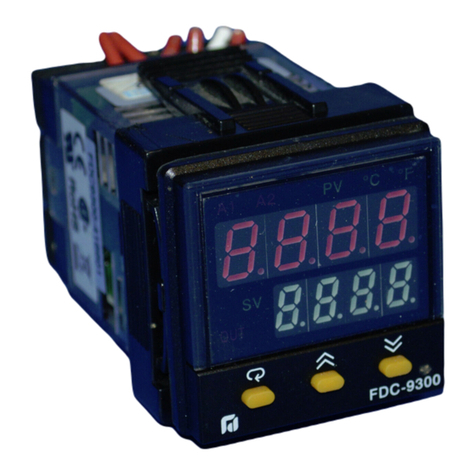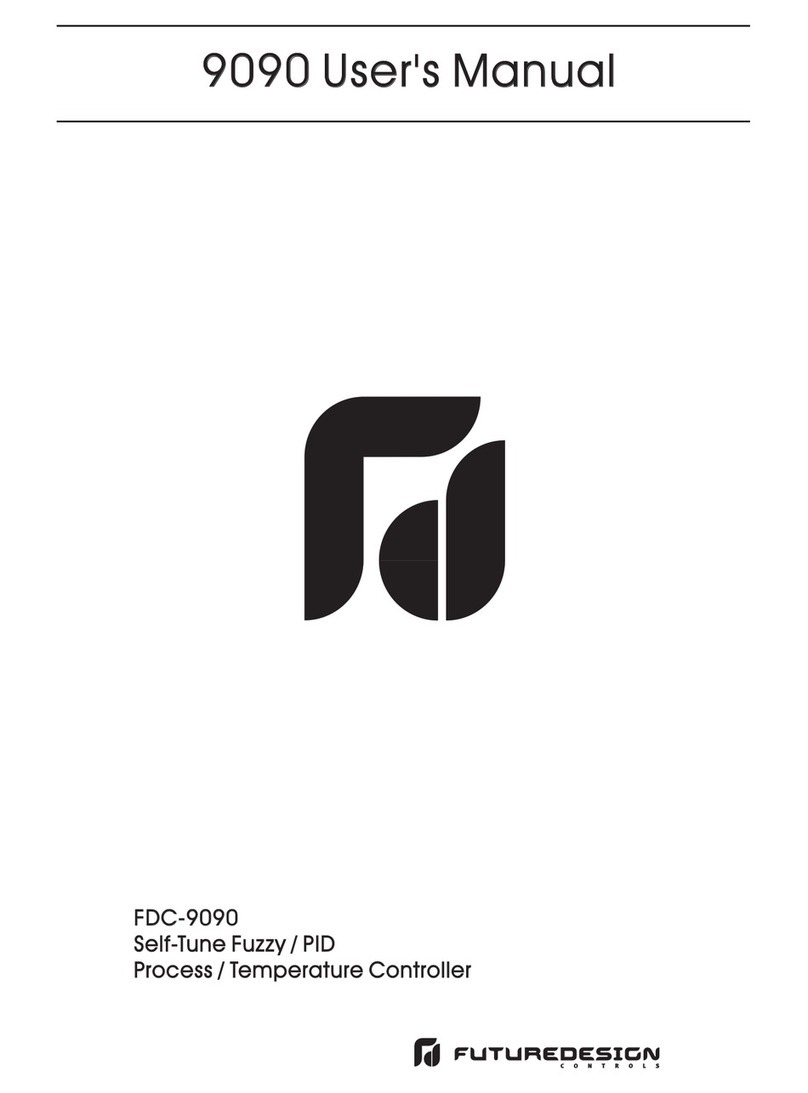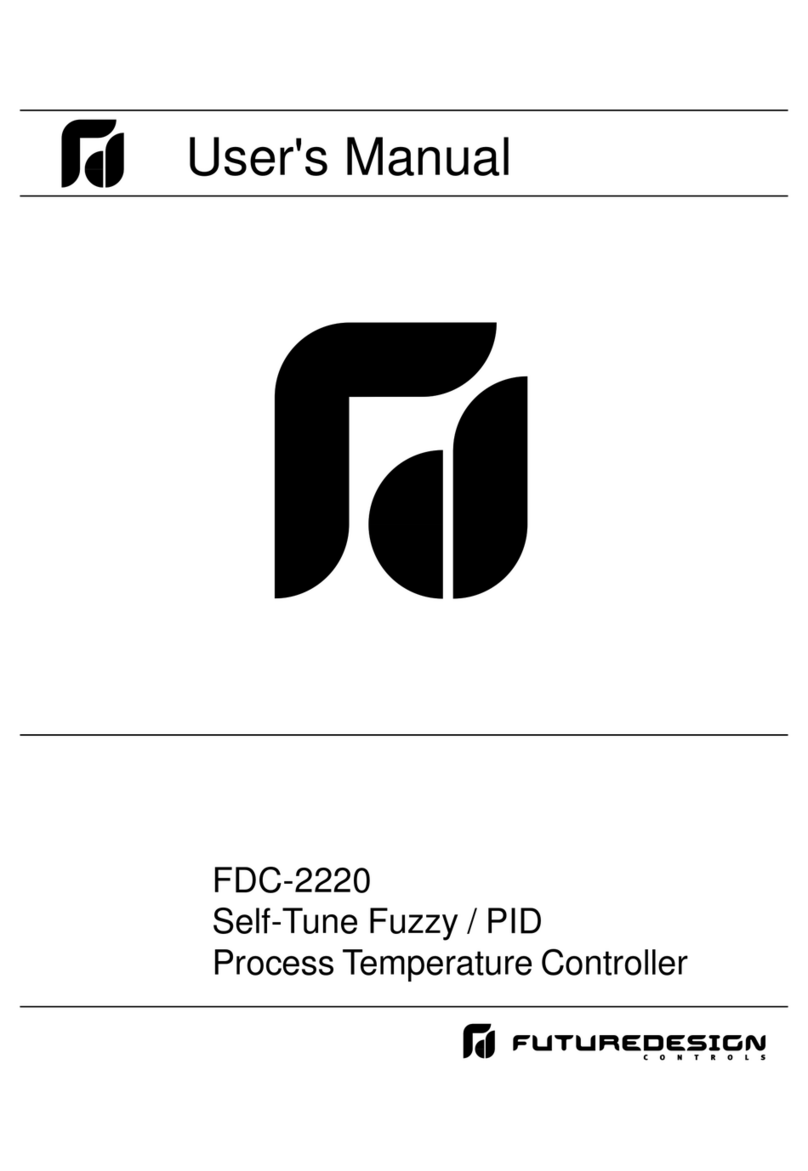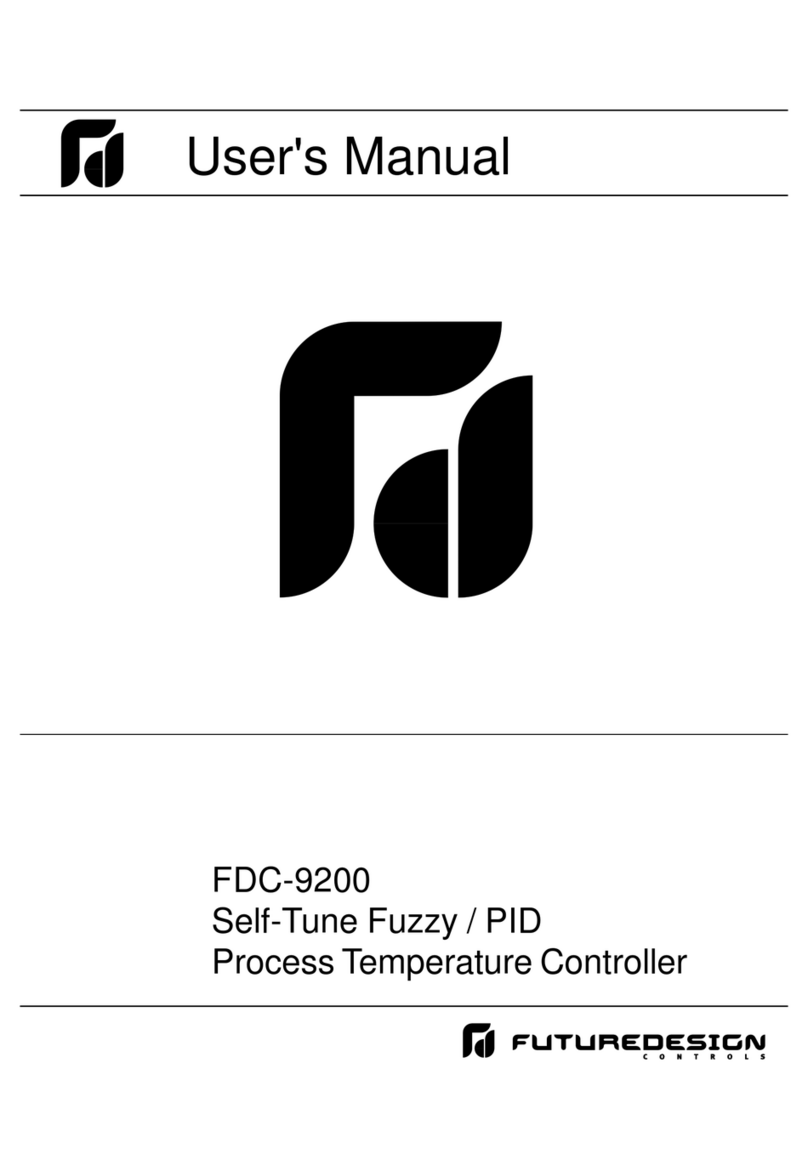
UM9090Rev1
6
8.4 AUTOMATIC TUNING
3. Press Return Key for at least 6 seconds ( maximum 16 seconds). This
initializes the Auto-tune function. (To abort auto-tuning procedure
press Return Key and release).
2. Ensure Proportional Band 'Pb' is not set at '0'.
1. Ensure that controller is correctly configured and installed.
4. The Decimal point in lower right hand corner of PV display flashes to
indicate Auto-tune is in progress. Auto-tune is complete when the
flashing stops.
5. Depending on the particular process, automatic tuning may take up
to two hours. Processes with long time lags will take the longest to
tune. Remember, while the display point flashes the controller is
auto-tuning.
NOTE: If an AT error( ) occurs, the automatic tuning process
is aborted due to the system operating in ON-OFF control(PB=0).
The process will also be aborted if the set point is set to close to
the process temperature or if there is insufficient capacity in the
system to reach set point (e.g. inadequate heating power
available). Upon completion of Auto-tune the new P.I.D. settings
are automatically entered into the controller's non-volatile memory.
8.5 MANUAL P.I.D. ADJUSTMENT8.5 MANUAL P.I.D. ADJUSTMENT
Whilst the auto-tuning function selects control settings which should prove
satisfactory for the majority of processes, you may find it necessary to
make adjustments to these arbitrary settings from time to time. This may
be the case if some changes are made to the process or if you wish to
'fine-tune' the control settings.
It is important that prior to making changes to the control settings that
you record the current settings for future reference. Make slight changes
to only one setting at a time and observe the results on the process.
Because each of the settings interact with each other, it is easy to become
confused with the results if you are not familiar with process control
procedures.
TUNING GUIDE
TUNING GUIDE
Proportional Band
Symptom Solution
Slow Response Decrease PB Value
High Overshoot or Oscillations Increase PB Value
Integral Time (Reset)
Symptom Solution
Slow Response Decrease Integral Time
Instability or Oscillations Increase Integral Time
Derivative Time (Rate)
Symptom Solution
Slow Response or Oscillations Decrease Deriv. Time
High Overshoot Increase TimeDeriv.
8.6 MANUAL TUNING PROCEDURE8.6 MANUAL TUNING PROCEDURE
Step 1: Adjust the integral and derivative values to 0. This inhibits the
rate and reset action
Step 2: Set an arbitrary value of proportional band and monitor the
control results
Step 3: If the original setting introduces a large process oscillation, then
gradually increase the proportional band until steady cycling
occurs. Record this proportional band value(Pc).
Step 4: Measure the period of steady cycling
PV
PV(Process value)
Tc
TIME
Record this value (Tc) in seconds
Step 5: The Control Settings are determined as follows:
Proportion Band(PB)=1.7 Pc
Integral Time (TI)=0.5 Tc
Derivative Time(TD)=0.125 Tc
25
50
75
100
125
150
010 20 30 40 50 60 70 80 90
15 minutes
ON OFF
Process Value
Alarm Output
t(minutes)
The dwell function may be used to operate an external device such
as a siren to alert when a soak time has been reached.
need to be set to the value 13. The alarm contact will now
operate as a timer contact, with the contact being open on the
initial start up. The timer begins to count down once the set point
temperature is reached. After the setting at has elapsed, the
alarm contact closes.
9. ERROR MESSAGES9. ERROR MESSAGES
Symptom Cause (s) Solution (s)
Sensor break error Replace RTD or sensor
Use manual mode operation
Process display beyond
the low range set point Re-adjust value
Re-adjust value
Process display beyond
the high range set point
Analog hybrid module
damage
Incorrect operation of
auto tune procedure
Prop. Band set to 0
Manual mode is not
allowable for an ON-OFF
control system
Check sum error, values
in memory may have
changed accidentally
Replace module. Check for
outside source of damage
such as transient voltage spikes
Repeat procedure. Increase
Prop. Band to a number larger
than 0
Increase proportional band
Check and reconfigure the
control parameters
8.7 RAMP & DWELL8.7 RAMP & DWELL
The FDC-9090 controller can be configured to act as either a fixed
set point controller or as a single ramp controller on power up. This
function enables the user to set a pre-determined ramp rate to
allow the process to gradually reach set point temperature, thus
producing a 'Soft Start' function.
A dwell timer is incorporated within the FDC-9090 and the alarm
relay can be configured to provide either a dwell function to be
used in conjunction with the ramp function.
The ramp rate is determined by the ' ' parameter which can be
adjusted in the range 0 to 200.0 C/minute. The ramp rate function
is disabled when the ' ' parameter is set to ' 0 '.
B
The soak function is enabled by configuring the alarm output to act
as a dwell timer. The parameter needs to be set to the
value 12. The alarm contact will now operate as a timer contact,
with the contact being closed at power up and opening after the
elapsed time set at parameter .
If the controller power supply or output is wired through the alarm
contact, the controller will operate as a guaranteed soak controller.
In the example below the Ramp Rate is set to 5 C/minute,B
=12 and =15 (minutes). Power is applied at zero
time and the process climbs at 5 C/minute to the set point of 125
C. Upon reaching set point, the dwell timer is activated and after
the soak time of 15 minutes, the alarm contact will open, switching
off the output. The process temperature will eventually fall at an
undetermined rate.
B
B
BC




























